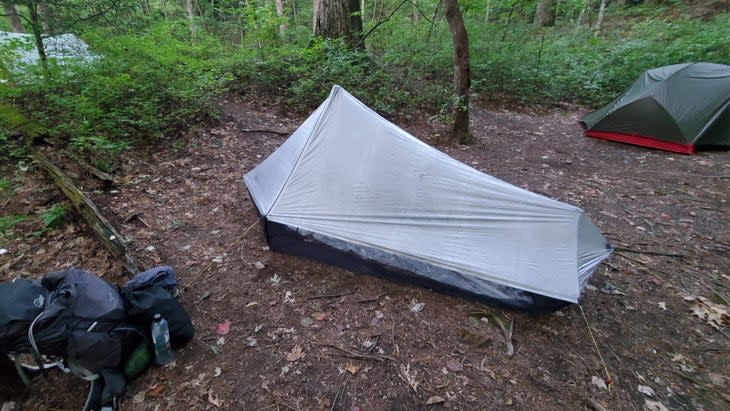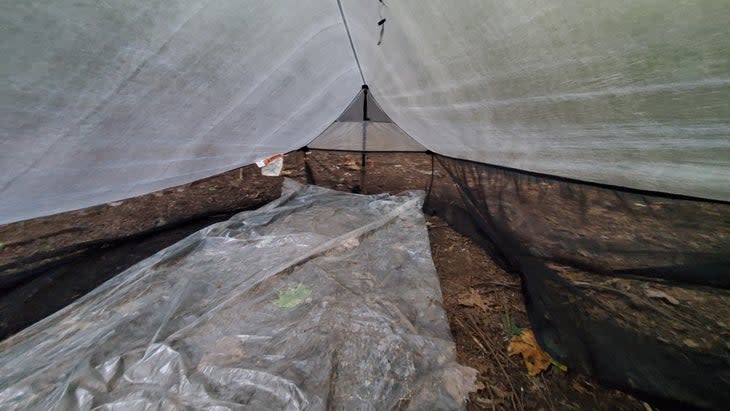Gossamer Gear Just Released a Limited-Edition, 9.8-Ounce Shelter
This article originally appeared on Backpacker
Gossamer Gear's latest shelter, a $500, 9.8-ounce Dyneema offering called the Whisper, isn't for everyone. In fact, there's only one person that it definitely is for, and that's founder Glen Van Peski, who designed the shelter according to his own specifications.
"The Whisper is kind of the pointy end of the ultralight spear," says Van Peski. "Just because I like something, we know that doesn't mean there's many other people that think it's a great idea."
If anyone knows about the extreme side of ultralight gear, it's Van Peksi, who over the years has experimented with three-pound base weights, crotch pots, and forgoing sleeping pads for well-placed divots in the ground. If there's a viable way to cut pack weight, Van Peski has probably tried it.
The Whisper is designed as a middle ground between a simple tarp and a more sophisticated trekking pole tent. It's a shaped, catenary-cut tarp with a "bug skirt" and no floor. It sets up with two trekking poles (one at the apex of the tent and one at the foot) and seven stakes. All seams are taped, and the single zipper on the door is waterproof.
The space that the Whisper occupies on the ultralight spectrum has been largely empty before this. Most ultralighters stick to trekking pole tents, and those who go lighter mostly use tarps and bivy sacks. Because of this, Gossamer Gear isn't sure how many they can sell, and chose to produce just 100 of the shelters.
"It wasn't a marketing ploy," says Van Peski. "Our thinking was, there might be 100 people that think this is a good idea, but probably not more than that."

Gossamer Gear sent me a demo of the Whisper to try out, which I took on a three-day backpacking trip in North Carolina's Pisgah National Forest. My experience? While the Whisper is highly specialized, I think it's a solid choice if you know what you're getting into.
The Whisper was simple to pitch, though I did have some trouble at first with drooping side panels, which shrank the interior space. After a bit of fiddling with the stakes and guylines (particularly, re-staking the guylines opposite the door and tightening the line on the door), things improved. I was also immediately impressed by the coverage the Whisper provided. The overall footprint was larger than I expected, and the sides of the tarps extend further to the ground than other superlight shelters I've used. An 8-by-10 foot Dyneema tarp might weigh an ounce or two less, but the Whisper provides better rain coverage than any pitch I've come up with for a flat tarp.
I was also curious to see how the most unique part of the Whisper's design--the mesh bug skirt--looked in a real-world setting, and came away pleasantly surprised. Rather than hanging loosely, the mesh is cut and sewn so that the net extends inward and lies flat on the ground. When I got a taut pitch, the net naturally fell into place without fiddling with it.
There are certainly a lot of tradeoffs to note when using the Whisper. The most obvious is the lack of a floor, which is probably a no-go for many backpackers. But anyone who uses a tarp or cowboy camps regularly would be comfortable in the Whisper. The mesh skirt, paired with a generously sized groundsheet, creates a full-coverage floor of sorts, though there's obviously no "bathtub" floor to speak of.

The second drawback is that the bug net is only effective with the door of the shelter closed. In the wrong conditions (buggy and humid), I could see myself being forced to make a tough choice--open the door and let mosquitos in, or keep it closed and contend with condensation. For that reason, I'd consider the Whisper better suited to the climates out west, where the air is drier and ventilation isn't as important. If I lived on the East Coast, I'd be looking at a different shelter for most trips.
Finally, the design of the Whisper places a trekking pole in the interior of the tent, situated between the door and your sleeping quarters. In order to maximize interior room, I moved the base of the pole both towards the head of the shelter and towards the door, which didn't seem to affect the pitch of the shelter. Still, the fact remains that you'll be sleeping with the trekking pole only a few inches from your body, which can feel a bit claustrophobic, especially if you toss and turn at night. In other ways, however, the Whisper feels downright roomy, especially compared to other shelters that clock in under a pound. There's pretty good headroom (Gossamer Gear recommends setting the center trekking pole to about 51 inches) and the shelter's length (102 inches) is longer than many tents that weigh two or three times as much.
Van Peski is right--the Whisper isn't for everyone. Part of that might be the lack of a floor, but it's also a lack of versatility. If you're the type to set up your bug net without a rainfly or tarp to see the stars, the Whisper won't do that. If you like having a big vestibule to store your pack or muddy boots, well, the Whisper doesn't really have one. And if you want 100 percent certainty that ticks, mice, and other critters can't get into your tent, the Whisper's mesh skirt can't provide that, either.
Still, I think there's a core ultralight hiker who should find this shelter very enticing, whether that's tarp and bivy users who want something with a simpler pitch, PCT thru-hikers who cowboy camp every other night anyway, or anyone who looks at a one-pound trekking pole tent and thinks, "Surely there's a lighter option out there." The way ultralight gear has moved into the mainstream over the past decade, it wouldn't surprise me at all if Gossamer Gear ends up selling a lot more than 100 of these.
For exclusive access to all of our fitness, gear, adventure, and travel stories, plus discounts on trips, events, and gear, sign up for Outside+ today.

